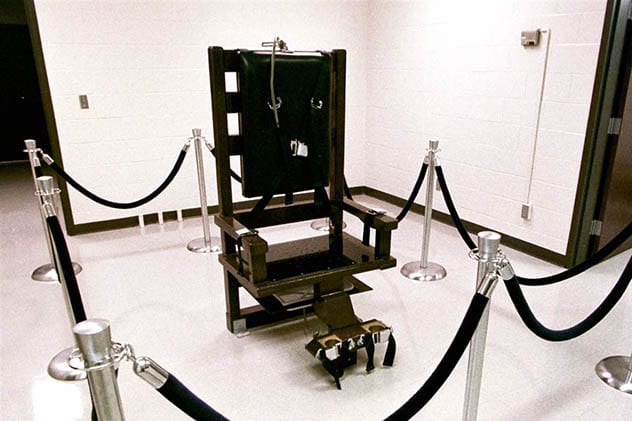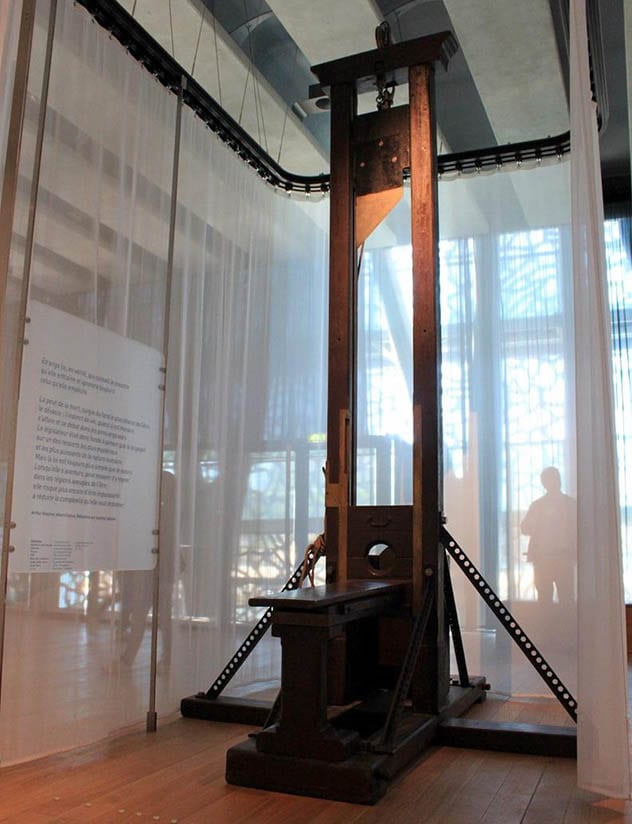 Weird Stuff
Weird Stuff  Weird Stuff
Weird Stuff  The Arts
The Arts 10 Extremely Strange Designs of Common Musical Instruments
 Crime
Crime 10 Jaw-Dropping Prison Escapes Involving Helicopters
 Technology
Technology Using 10 Well-Known Technologies in the Most Unusual Ways
 Miscellaneous
Miscellaneous 10 Badly Damaged Trademarks That May Never Recover
 Books
Books 10 Famous Poisoned Pen Biographies
 History
History 10 of the Most Unusual Deaths Ever Recorded in History
 Humans
Humans 10 Amazing Origins of Human Body Parts
 Crime
Crime 10 Weirdly Specific Crime Waves from the Last Two Centuries
 Creepy
Creepy 10 Creepy Ancient Wooden Idols
 Weird Stuff
Weird Stuff 10 Strange Things Found Inside Other Things
 The Arts
The Arts 10 Extremely Strange Designs of Common Musical Instruments
 Crime
Crime 10 Jaw-Dropping Prison Escapes Involving Helicopters
Who's Behind Listverse?

Jamie Frater
Head Editor
Jamie founded Listverse due to an insatiable desire to share fascinating, obscure, and bizarre facts. He has been a guest speaker on numerous national radio and television stations and is a five time published author.
More About Us Technology
Technology Using 10 Well-Known Technologies in the Most Unusual Ways
 Miscellaneous
Miscellaneous 10 Badly Damaged Trademarks That May Never Recover
 Books
Books 10 Famous Poisoned Pen Biographies
 History
History 10 of the Most Unusual Deaths Ever Recorded in History
 Humans
Humans 10 Amazing Origins of Human Body Parts
 Crime
Crime 10 Weirdly Specific Crime Waves from the Last Two Centuries
 Creepy
Creepy 10 Creepy Ancient Wooden Idols
Top 10 Dark Facts About The Death Penalty [DISTURBING]
[WARNING: This list includes disturbing images.] The death penalty remains one of the most controversial topics in modern times. Much of the developed world – including Australia, New Zealand, every EU nation except Belarus and 22 of the 50 US states – has abolished the practice.
Whether or not it is inhumane or deters heinous crimes, the death penalty has always provided intriguing details along with heated debate. Legal executions create a macabre subculture and, right or wrong, bring with them fascinating circumstances and stories.
10 Brutal Facts About The Most Humane Method Of Execution
10 The Electric Chair: Shocking Truths

Death by electrocution originated in the 1880s as a means of killing cattle, lame horses and stray animals. Its efficiency and seeming painlessness were soon seen as a superior means of executing condemned criminals then the era’s most common method, hanging.
Among the early proponents of human execution was the period’s most prominent electricity enthusiasts: Thomas Edison. In fact, Edison was so enamored with the concept that he staged press conferences – with an s, as in more than one – at which he shocked stray cats and dogs to death. How’s that for a phonograph[1] recording?
The electric chair was first used in 1890, and has served as a highly stimulating ending for more than a thousand U.S. inmates. Its central concept is a “double-tap” process in which the first jolt brings about unconsciousness, and the second damage to vital organs and, ultimately, death.
Unfortunately, like Netflix, this worst-case-scenario streaming service doesn’t always buffer properly – resulting in some truly horrific series finales.
In 1982, after an initial jolt incapacitated the condemned Frank Coppola, a second, near-minute-long current led to what witnesses claimed was the sound of sizzling flesh[2] as smoke filled the room (I like my Franks medium-rare. You?). Other horror stories involve gushing blood and even flames erupting[3] from a prisoner’s head.
9 A Cut Above?

The guillotine is an interesting contraption because, unlike a noose, a needle, a gun barrel or an electrified chair, it didn’t devise a means of death so much as improve upon an established one: beheading.
The commonly recognized French guillotine was a successor to several earlier devices, including the “planke,”[4] used in Germany during the Middle Ages. Still, beheadings by swords and axes were far more common – and often took several gruesome swings to complete the deed. In 1789, Dr. Joseph-Ignace Guillotin’s design promised decapitation with lightning speed and less human intervention.
It worked. So well, in fact, that it created a series of cottage industries.
First, it became the late 18th Century version of a tacky souvenir. Fascination with the guillotine led to its wide-scale miniature replication, to the point where some upper class dinner tables had novelty guillotines used to slice bread and vegetables (“Off with his head of lettuce!”). Disturbingly, mini-guillotines also became popular children’s toys,[5] with kids using fully operational, two-foot-tall models to decapitate dolls or even rodents.
Besides dangerous tschotskes, guillotines also inspired a macabre medical curiosity with how long a decapitated head stayed alive. The device lopped heads off so quickly, it was assumed, that the head must have a few seconds of life left – a sort of reverse “chicken with its head cut off” logic. As late as 1880, a doctor tried pumping blood into a guillotined head in hopes it would come back to life and speak.
The guillotine’s chopping power gave it staying power: it remained France’s official method of execution until 1977, when murderer Hamida Djandoubi become the last to receive the ultimate severance package.
8 Hanging Someone Means Going to Great Lengths

Throw the noose around his neck and kick away the chair, right? Wrong. Executing someone by hanging is far more complex.
For starters, an inmate may be weighed beforehand since it’s possible to be too heavy to hang,[6] as one 400-pound inmate was pronounced in 1994. In fact, heft is such a consideration that a rehearsal is often performed using a sandbag of the inmate’s approximate weight. This helps ensure that the proper length of rope[7] is used for the fastest-possible death. Too short a rope and the procedure could last as long as an excruciating 45 minutes; too long and the inmate could be decapitated.
Once its length is determined, the rope requires a painstaking process to limit the inmate’s suffering. It should be ¾-1¼” in diameter, boiled and stretched to eliminate spring and recoiling, and waxed to provide a smooth sliding action – all in an attempt to find a sweet spot that efficiently fractures the neck once the platform’s trap door opens.
There are, then, many small details that can be miscalculated, with the result being an elongated, agonizing death. If the rope isn’t just right or the noose improperly positioned, the intended vertebral fracture is not rapid and death results from slow asphyxiation. Such was the case with Billy Bailey, whose 1996 hanging in Delaware was the most recent instance of its use in the US. Bailey wasn’t pronounced dead for a full 11 minutes.[8]
7 Sparing the Psyche of Executioners

A death row execution isn’t just stressful for the soon-to-be dearly departed; it can take a sizable mental toll on executioners.
Often, executions are an especially unpleasant aspect of an already unpleasant job. In the United States, for example, when an order of execution is issued, the prison warden or superintendent is responsible for the sentence being carried out. Typically, the act ultimately falls to common corrections officers, many of whom were initially unaware that their position would involve killing people. Complicating matters, bonds are frequently formed between prisoners – many of whom sit on death row for years, through a series of appeals – and the same guards eventually charged with ending their lives.
Steps are often taken to mitigate[9] such PTSD issues. For example, with lethal injections – by far America’s most common form of execution – it is common for three corrections officers to each turn a switch that releases the lethal drug into the inmate. Only one “live” switch actually dispenses the fatal chemical, meaning the officers don’t know whether theirs was the one that did the deed.
Firing squads – which are still used in the U.S., albeit rarely – utilize a similar “masking” technique. Modern firing squad executions entail five anonymous gunmen, one of whom has a rifle loaded with a wax “dummy” bullet.[10] That way, none can ever be completely certain whether theirs was the fatal shot.
6 The Saudis Still Crucify People

Nothing says kickin’ it old school like kickin’ it New Testament. Unfortunately for some people sentenced to death in Saudi Arabia, that means being on the receiving end of the millennia-old practice of crucifixion.
In April 2019, Saudi Arabia executed 37 men – one of whom was just 16 years old at the time of arrest – for “adopting terrorist extremist ideology, forming terrorist cells and harming the peace and security of society,” which sounds rich for a country that supplied 15 of the 19 hijackers[11] who orchestrated the September 11, 2001 attacks.
Apparently one of the condemned men’s crimes was more egregious than those of his fellow accused terrorists, so the standard execution method of beheading just wouldn’t, well, cut it. So he was crucified.[12] Though in all fairness, in what seemingly passes for mercy in Saudi Arabia, he was beheaded before being crucified, making the procedure decidedly less painful.
Unfortunately this was not a lone incident. A year earlier, a man convicted of stabbing a woman to death was beheaded then crucified – a tragedy that, in conjunction with an accusation of human rights violations from Canada, prompted one of the most ridiculous headlines ever: “Saudi Arabia Rejects Human-Rights Criticisms, Then Crucifies Someone”.[13] In 2009, a beheaded man’s head was actually sewn back onto his body[14] before crucifixion.
10 Executions As Told By The Executioners
5 Stone Cold Bigotry

And the award for most disgusting execution protocol goes to: Brunei, for its recently adopted law that punishes adultery and sodomy with death… by STONING. In doing so, Brunei triumphantly joined[15] beacons of enlightenment Iran, Saudi Arabia, Yemen, Sudan, Mauritania, Nigeria and Somalia as countries where same-sex relationships can bring the death penalty.
Stoning – known as lapidation[16] by more well-heeled rock-hurling enthusiasts – is the death penalty version of a dunk tank. The victim is made stationary, typically by burying all but his head underground, while aspiring relief pitchers throw fastballs at his head. It’s basically how people killed each other before they discovered fire and tools, which actually aligns well with Brunei’s general level of sophistication.
But ladies, you’re in luck! Brunei’s views on lesbianism are, comparably, refreshingly progressive: Lesbian sex “only” carries a penalty of 40 strokes of the cane and/or up to 10 years in jail.
And never fear: as always, we can count on Hollywood to come to the moral rescue. Reacting to the brutal regime’s disgusting laws, George Clooney called for a boycott of Brunei’s luxury hotels.[17] That oughta teach ‘em.
4 Last Word Freaks

When your publicly recorded death is scheduled well in advance, you have ample time to concoct some memorable parting thoughts.
The last words of death row inmates[18] range from maniacal to mundane. On the batshit crazy side of the spectrum, in 2002 #FloridaWoman and apparent Will Smith fan Aileen Wuornos confidently remarked that “I’d just like to say I’m sailing with the Rock and I’ll be back like ‘Independence Day’ with Jesus, June 6, like the movie, big mother ship and all.” Fifteen years earlier, in Louisiana, Jimmy Glass was less enthusiastic about the end-of-life endeavor, simply sharing “I’d rather be fishing.”
Put to death in Oklahoma in 2011, Jeffrey Matthews had either a really excellent sense of humor or a really poor IQ: “I think that governor’s phone is broke,” he stated, referring to the possibility of a last-minute stay of execution. “He hasn’t called yet.” In 1995, Thomas Grasso wanted the world to know about his alleged last meal mix-up: “I did not get my Spaghetti-O’s. I got spaghetti. I want the press to know this.” Duly noted, good sir.
Other death row inmates literally leave ‘em laughing. Just before the switch was thrown on his electric chair in 1928, George Appel had enough humor left to inform his captors they were “about to see a baked Appel.” Facing the same fate four decades later, James French turned amateur journalist: “How about this for a headline for tomorrow’s paper?” he smirked. “‘French Fries’.”
3 Last Bites

Another thing death row inmates have plenty of time to consider is their final meal.
A review of last meals through the years shows that inmates tend to favor A LOT of food over particularly fancy ones. In 2011, Steven Woods[19] ordered up “two pounds of bacon, a large four-meat pizza, four fried chicken breasts, two drinks each of Mountain Dew, Pepsi, root beer, and sweet tea, two pints of ice cream, five chicken fried steaks, two hamburgers with bacon, fries, and a dozen garlic bread sticks with marinara on the side.”
Red meat, fries and ice cream all seem to be popular last meal selections. After all, they’re there to die, not diet. Still, some last meals are strikingly simple. Aileen Wuomos requested a black coffee, while Karla Faye Tucker chose to keep her girlish figure for all eternity by ordering “a garden salad with Ranch style dressing, a banana and a peach.”
Phillip Workman was more altruistic about the whole endeavor, declining food for himself but asking that a pizza be given to a hungry homeless person. The prison refused, but hundreds of people took Workman up on the offer.[20]
And of course, there’s always the guy that ruins it for everyone else. Prior to his 2011 execution at Texas State Prison, murderer Lawrence Russell Brewer demanded a huge, highly specific meal… then refused to eat it. The prison then stopped taking last meal requests.[21]
2 Last Look: Watching the Condemned Die

Often, an inmate sentenced to die goes from a death watch to a death watch party.
While public executions in developed nations are a thing of the past – for example, the US hasn’t held one since 1936 – many execution sites still have watch rooms where a select few can bear witness to an inmate’s demise.
In the US, exactly who can be present at the bitter end varies by state but, in general, the list is surprisingly lengthy.[22] In addition to the prison warden, corrections officers and medical personnel, witnesses to executions frequently include certain state officials, members of the media, religious leaders and/or spiritual advisors and a purposefully vague category called an official group of “reputable citizens.”
This last clique can include criminologists, law students or even everyday curious citizens. And while they seem extraneous, some states actually require the presence of these unaffiliated civilians at executions – as evidenced by this call for volunteers.[23] One Virginia married couple apparently makes date nights out of it.[24]
The other two categories, when combined, are most awkward indeed: the relatives of both the condemned inmate and his victim(s) also may be present, prompting the execution equivalent of a wedding usher’s greeting: “Are you with the dead, or the dying?”
1 What’s Next? The Future of Executions

Today, lethal injection is by far the most commonly employed execution method. However, ongoing shortages of the drugs typically used for the practice have led some to experiment with alternatives. The result has been a slate of botched executions, including one that took two hours and 640 gasps[25] before the inmate died.
This has prompted efforts to explore new alternatives. One possibility is nitrogen hypoxia,[26] which replaces air with an inert gas like nitrogen or helium. The idea initially gained traction after a BBC documentary presented by former UK Parliament member Michael Portillo called it “a perfect killing device”[27] in a widely viewed BBC documentary.
Air is 78% nitrogen, so it’s an easily obtainable gas, and nitrogen hypoxia is typically quick: a study during the 1960s found breathing pure nitrogen resulted in lost consciousness in about 20 seconds.
The notion was, in part, concocted from the cockpit: the higher a plane climbs, the thinner the air, which is when pilots in non-pressurized planes need supplemental oxygen. Hypoxia’s subtle symptoms – lightheadedness, disorientation – make it particularly deadly to pilots at high altitude, who may not recognize that anything is wrong. It has been blamed for several small-plane crashes in recent years.
The US states of Oklahoma, Alabama and Mississippi[28] have authorized nitrogen hypoxia as a suitable method of execution, and are developing protocols to utilize it despite noted criticisms.
10 Horrifically Botched Executions
About The Author: Christopher Dale (@ChrisDaleWriter) writes on politics, society, and sobriety issues. His work has appeared in Daily Beast, NY Daily News, NY Post, and Parents.com, among other outlets.
![9 Sinister Facts About The Dark Side Of Instagram [WARNING: Disturbing] 9 Sinister Facts About The Dark Side Of Instagram [WARNING: Disturbing]](https://listverse.com/wp-content/uploads/2019/10/proxy.duckduckgo-150x150.jpg)







